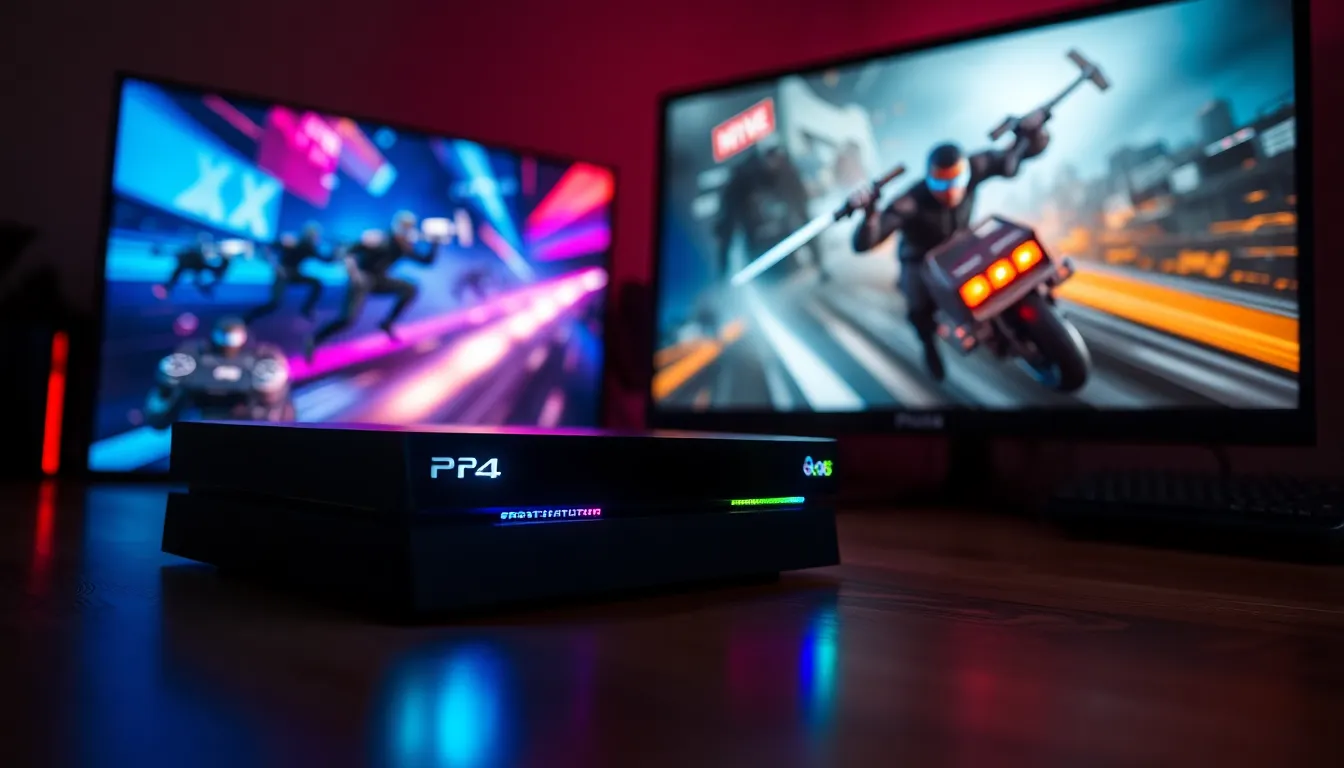Table of Contents
ToggleIn the world of gaming, frame rate can make or break the experience. For PS4 players, understanding frame rate is crucial to unlocking the full potential of their favorite titles. A higher frame rate often translates to smoother gameplay, sharper visuals, and a more immersive experience, making it a hot topic among gamers.
As developers continue to push the boundaries of graphics and performance, the PS4’s capabilities come into focus. With various games optimized for different frame rates, players often find themselves wondering how to achieve the best performance. This article dives into the intricacies of PS4 frame rate, exploring its impact on gameplay and offering insights on how to enhance gaming sessions for ultimate enjoyment.
Overview of PS4 Frame Rate
PS4 frame rate plays a crucial role in the gaming experience. It defines the number of frames displayed per second (FPS), influencing the fluidity of gameplay. Most PS4 games aim for a minimum of 30 FPS, while many strive for 60 FPS, offering significantly smoother visuals.
Frame rates can fluctuate based on game demands, system performance, and graphical settings. For instance, some titles prioritize higher graphical fidelity, resulting in lower frame rates. Meanwhile, competitive games often optimize for frame rate over graphics, ensuring responsive gameplay.
Understanding frame rates helps players make informed choices. Players can find settings within game menus to adjust graphics and performance modes based on their preferences. Monitoring frame rate during gameplay can assist in making necessary adjustments for optimal performance.
The PS4 Pro offers enhanced capabilities, allowing some games to reach up to 60 FPS with increased resolutions, improving overall visual quality. In addition, features like Boost Mode enable players to experience improved frame rates even in older titles.
Players can use tools such as frame rate monitors to assess performance objectively. Consistent frame rates reduce lag and hiccups, providing a more enjoyable gaming experience.
Factors Influencing PS4 Frame Rate

Several factors impact PS4 frame rate, determining the gaming experience’s fluidity and visual quality. Players should consider hardware limitations and game optimization for improved performance.
Hardware Limitations
Hardware limitations significantly affect PS4 frame rate. The PS4’s GPU and CPU play crucial roles in processing graphics and performance.
- GPU capacity: The PS4 GPU, with a performance peak of 1.84 teraflops, handles rendering, textures, and effects. Intensive graphics demand can lead to frame rate drops.
- CPU performance: The PS4 features an eight-core AMD Jaguar CPU. Limited processing power can hinder performance in CPU-intensive titles.
- RAM availability: The system operates with 8GB of GDDR5 RAM. Memory usage impacts frame rates, especially when multiple tasks run simultaneously.
- Cooling systems: Overheating can cause throttling, reducing frame rates. Effective cooling mechanisms prevent performance degradation during lengthy gaming sessions.
Understanding these hardware components helps players grasp performance limitations.
Game Optimization
Game optimization significantly impacts frame rate variations across different titles. Developers employ various strategies to ensure smooth performance.
- Resolution settings: Many games offer resolution choices. Lowering resolution can provide higher frame rates by reducing graphical workload.
- Dynamic scaling: Some titles utilize dynamic resolution scaling, adjusting graphical fidelity in real-time to maintain consistent frame rates.
- Texture quality: Reducing texture quality affects visual fidelity but can improve frame rates, especially in demanding environments.
- Frame rate caps: Developers often impose frame rate caps for stability. Many competitive games target 60 FPS, optimizing responsiveness.
Game optimization techniques directly influence the overall gaming experience, emphasizing the importance of adjusting settings for individual preferences.
Frame Rate Performance in Popular Games
Frame rate performance varies significantly among popular PS4 titles, impacting gameplay experiences. Both AAA titles and indie games showcase different frame rate capabilities and optimizations.
AAA Titles
Many AAA titles achieve impressive frame rates due to optimized game engines and high production values. Games like The Last of Us Part II and God of War typically run at 30 FPS, enhancing visual fidelity with rich graphics. Some titles, such as Call of Duty: Warzone, can push frame rates closer to 60 FPS, particularly on the PS4 Pro. Developers often implement techniques like dynamic resolution scaling and variable refresh rates to maintain performance during intense action sequences. These modern game developments allow for smoother gameplay, especially in fast-paced environments where maintaining high frame rates is beneficial for competitive play.
Indie Games
Indie games frequently offer unique experiences with varying frame rates due to their diverse development scopes. Titles like Hollow Knight and Celeste commonly target 60 FPS, ensuring fluid animation and responsive control. Their simpler graphics allow for smoother performance, often focusing on gameplay mechanics rather than graphic-heavy elements. Additionally, many indie developers prioritize optimization, enabling their games to run well even on standard PS4 systems. This focus on frame rate in indie games highlights the importance of performance in delivering engaging and enjoyable player experiences.
How to Improve PS4 Frame Rate
Improving the frame rate on a PS4 involves adjusting settings and maintaining the system effectively. Implementing these strategies can enhance gameplay performance significantly.
Adjusting Game Settings
- Lower Resolution: Decreasing the resolution can alleviate the graphical load, resulting in a higher frame rate.
- Turn Off Motion Blur: Disabling motion blur enhances clarity during fast-paced gaming, improving visual responsiveness.
- Reduce Texture Quality: Setting texture quality to lower levels can help maintain smoother frame rates, especially in graphically demanding titles.
- Disable V-Sync: Turning off vertical sync can reduce input lag, allowing for quicker frame response in competitive games.
- Use Performance Modes: Selecting performance mode when available in game settings prioritizes frame rate over graphical fidelity, facilitating a smoother experience.
System Maintenance Tips
- Clear Dust from Console: Regularly cleaning the console’s exterior and vent areas prevents overheating and maintains optimal performance.
- Check Hard Drive Space: Ensuring sufficient storage space allows the PS4 to function efficiently, with at least 10-15% of the hard drive empty for the best performance.
- Update System Software: Keeping the PS4’s software updated enhances performance, as updates often include performance fixes and optimizations.
- Close Background Applications: Closing unused applications running in the background helps allocate resources, improving the frame rate during gameplay.
- Use a Wired Connection: Connecting the PS4 to the internet via a wired Ethernet connection reduces latency and improves the overall gaming experience.
Understanding PS4 frame rates is crucial for gamers seeking an optimal experience. Higher frame rates contribute to smoother gameplay and improved visuals, significantly enhancing immersion. By adjusting settings and utilizing performance modes, players can tailor their gaming experience to their preferences.
Maintaining the PS4 system is equally important. Regular cleaning and software updates can prevent performance dips. With the right strategies in place, players can enjoy a more fluid gaming experience, regardless of the title they choose. Embracing these insights ensures that every gaming session is engaging and enjoyable.





